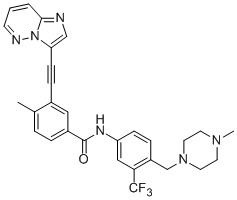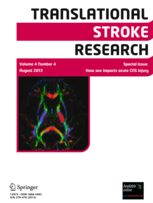All AbMole products are for research use only, cannot be used for human consumption.

Ponatinib (AP24534) is a novel potent BCR-ABL or BCR-ABLT3151 with an IC50 values of 0.37 and 2.0 nM, respectively. Ponatinib (AP24534) also inhibits other ABL kinase domain mutants at nanomolar potencies. AP24534 exhibits inhibitory activity against PDGFRα, c-Src and c-Kit (IC50 values are 1.1, 5.4 and 12.5 nM respectively) potently inhibits FGFR and VEGFR family kinases.

J Virol. 2020 Feb 14;94(5):e01791-19.
Targeting Kaposi's Sarcoma-Associated Herpesvirus ORF21 Tyrosine Kinase and Viral Lytic Reactivation by Tyrosine Kinase Inhibitors Approved for Clinical Use
AP24534 purchased from AbMole

Transl Stroke Res. 2017 Nov 4.
Combination of Emricasan with Ponatinib Synergistically Reduces Ischemia/Reperfusion Injury in Rat Brain Through Simultaneous Prevention of Apoptosis and Necroptosis
AP24534 purchased from AbMole
| Cell Experiment | |
|---|---|
| Cell lines | MV4-11, Kasumi-1, KG1, and EOL1 cells |
| Preparation method | Cell viability assays. Cell viability was assessed using the Cell Titer 96 Aqueous One Solution Cell Proliferation Assay. Exponentially growing cell lines were plated into 96-well plates and incubated overnight at 37°C. Twenty-four hours after plating, cells were treated with compound or vehicle (dimethyl sulfoxide) for 72 hours. Absorbance was measured using a Wallac Victor microplate reader (PerkinElmer). Data are plotted as percent viability relative to vehicle-treated cells and the IC50 values (the concentration that causes 50% inhibition) are calculated using XLfit version 4.2.2 for Microsoft Excel. Data are shown as mean (±SD) from 3 separate experiments, each tested in triplicate. |
| Concentrations | 0~100 nM |
| Incubation time | 72 h |
| Animal Experiment | |
|---|---|
| Animal models | MV4-11 human tumor subcutaneous xenograft model |
| Formulation | aqueous 25 mmol/L citrate buffer (pH = 2.75) |
| Dosages | 1, 2.5, 5, 10, and 25 mg/kg/d once daily for 4 weeks |
| Administration | orally |
| Molecular Weight | 532.56 |
| Formula | C29H27F3N6O |
| CAS Number | 943319-70-8 |
| Solubility (25°C) | DMSO ≥ 40 mg/mL |
| Storage |
Powder -20°C 3 years ; 4°C 2 years In solvent -80°C 6 months ; -20°C 1 month |
| Related Src-bcr-Abl Products |
|---|
| KX2-361
KX2-361 (KX-02) is a Src-kinase and tubulin polymerization inhibitor. KX2-361 shows anti-tumor activity and induces apoptosis of Glioblastoma (GBM) cell. KX2-361 shows good oral bioavailability and readily crosses the BBB in mice. |
| Risvodetinib
Risvodetinib (IkT-148009) is an orally active, selective and brain-penetrant protein tyrosine kinase inhibitor, displaying excellent target efficacy against c-Abl1, c-Abl2/Arg with IC50 values of 33 nM, 14 nM, respectively. |
| SI-2 hydrochloride
SI-2 hydrochloride is a highly promising SRC-3 inhibitor (PPI) with acceptable oral availability, with IC50 values of 3-20 nM for breast cancer cell death. |
| KB SRC 4
KB SRC 4 is a potent, and highly selective c-Src inhibitor, with a Ki of 44 nM and a Kd of 86 nM, and shows no inhibition on c-Abl up to 125 μM; KB SRC 4 has antitumor activity. |
| Hydroxymethyl dasatinib
Hydroxymethyl dasatinib (M24), a benzylhydroxy metabolite of Dasatinib, exhibits an IC50 of 46.7nM in K562 CML cells. |
All AbMole products are for research use only, cannot be used for human consumption or veterinary use. We do not provide products or services to individuals. Please comply with the intended use and do not use AbMole products for any other purpose.


Products are for research use only. Not for human use. We do not sell to patients.
© Copyright 2010-2024 AbMole BioScience. All Rights Reserved.
